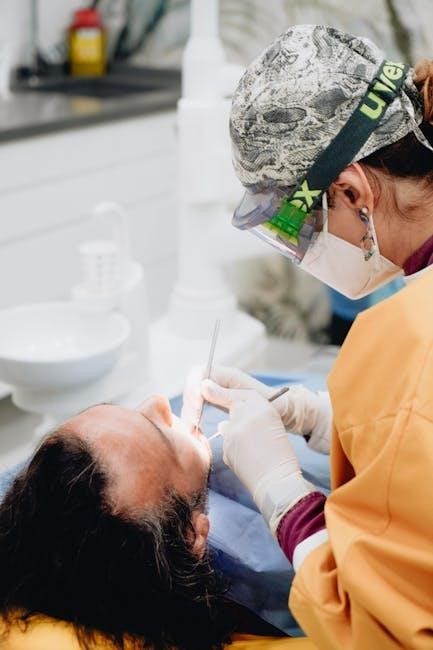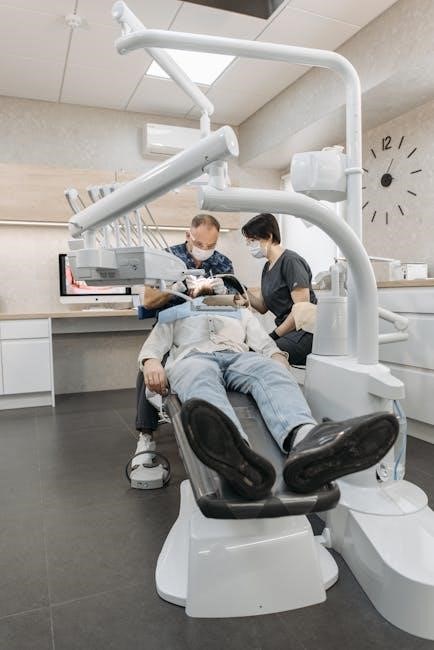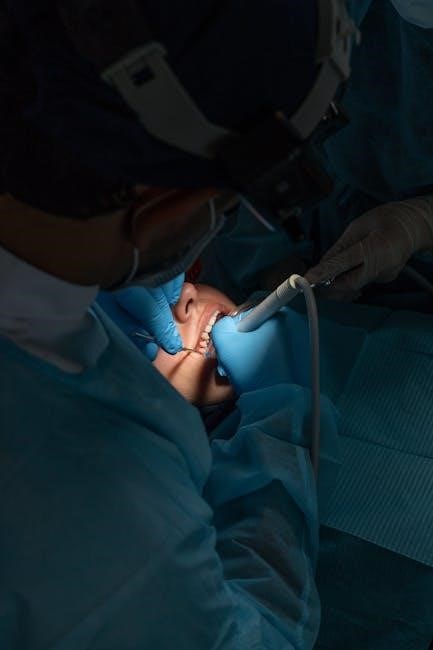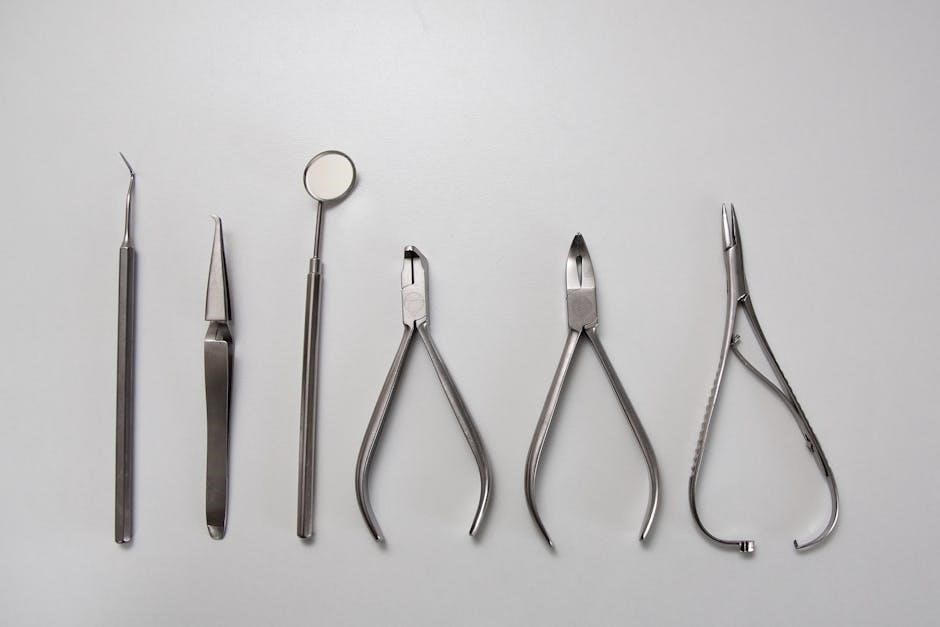
Guided surgery for dental implants is a modern, technology-driven approach that enhances precision and predictability in implant placement, utilizing digital planning and 3D imaging for optimal outcomes.
What is Guided Surgery?
Guided surgery in dental implants is a technology-driven method using digital planning and surgical guides to ensure precise implant placement, enhancing accuracy and minimizing invasive procedures.
Digital Planning and 3D Imaging in Guided Surgery
Digital planning and 3D imaging are cornerstone technologies in guided surgery, enabling precise implant placement. Cone Beam CT (CBCT) scans create detailed 3D models of the jaw, allowing clinicians to visualize bone density, nerve locations, and surrounding anatomy. This data is used to design a virtual treatment plan, ensuring optimal implant positioning for aesthetic and functional outcomes. Specialized software facilitates the creation of surgical guides, which direct drill placement during surgery. These tools minimize human error and enhance surgical accuracy. Digital planning also allows for pre-operative simulations, reducing complications and improving patient-specific results. By integrating advanced imaging, guided surgery offers a highly predictable and efficient approach to dental implant placement.
Use of Surgical Guides in Implant Placement
Surgical guides are customizable templates used to direct implant placement with exceptional accuracy. Created from digital plans, these guides are tailored to fit the patient’s jaw, ensuring precise positioning of drills and implants. They are fabricated using 3D printing or stereolithography, based on CBCT scans and virtual treatment plans. Surgical guides minimize deviations, reducing human error and enhancing safety. They are particularly useful in complex cases, such as limited bone availability or proximity to vital structures. Some guides are designed for flapless surgery, reducing healing time. Markers on the guides provide orientation and depth control, ensuring implants are placed as planned. This tool is a cornerstone of guided surgery, offering a reliable and efficient method for achieving optimal implant placement outcomes.
The Process of Guided Surgery
The process involves integrating digital technology for precise planning, creating surgical guides, and accurately placing implants, ensuring efficiency and optimal results in implant placement.
Pre-Surgical Planning and Preparation
Pre-surgical planning is critical in guided surgery, involving detailed digital imaging and 3D modeling of the patient’s jaw. CBCT scans provide high-resolution images to assess bone density and anatomy. Using specialized software, dentists create precise treatment plans, identifying optimal implant positions for functionality and aesthetics. Virtual simulations allow clinicians to anticipate challenges and refine strategies. Custom surgical guides are designed and 3D-printed to fit the patient’s jaw, ensuring accurate implant placement. This preparation minimizes surgical complexity and enhances outcomes, offering a tailored approach for each patient. The integration of technology and careful planning ensures a predictable and efficient procedure, reducing risks and improving patient comfort.
Guided surgery begins with the patient under local anesthesia to ensure comfort. The custom surgical guide, created during pre-surgical planning, is securely placed over the jaw. This guide aligns with the patient’s anatomy, ensuring precise implant placement. The dentist then makes small incisions in the gum tissue, following the guide’s markings. Pilot holes are drilled into the jawbone at predetermined locations, and implants are carefully inserted. The surgical site is closed, and healing abutments or temporary restorations may be placed. Post-surgery instructions are provided to promote recovery. The entire process is efficient, minimizing tissue trauma and optimizing outcomes. This step-by-step approach ensures accuracy and reduces complications, leveraging advanced technology for predictable results.
Benefits of Guided Surgery
Step-by-Step Guide to the Surgery
Guided surgery begins with local anesthesia for patient comfort. A custom surgical guide, created from digital plans, is placed over the jaw to direct implant placement precisely. Small incisions are made in the gum, and pilot holes are drilled into the jawbone at marked locations. Implants are inserted into these holes, and the surgical site is closed. Temporary restorations may be added. Post-surgery care instructions are provided to aid healing. This method minimizes tissue damage and ensures accurate, predictable results, leveraging advanced technology for optimal outcomes.
Enhanced Accuracy and Precision
Guided surgery for dental implants leverages advanced technologies like CBCT scans and digital planning to achieve unparalleled accuracy. By creating detailed 3D models of the patient’s jaw, clinicians can identify optimal implant positions, ensuring precise alignment with surrounding structures. Custom surgical guides, fabricated from these digital plans, fit snugly over the jaw to direct drill placement, minimizing human error. This approach allows for exact positioning, improving both functional and aesthetic outcomes. The use of real-time navigation systems further enhances precision, reducing complications and ensuring implants are placed in the most biologically favorable locations. This level of accuracy not only improves the success rate of implants but also minimizes trauma to surrounding tissues, leading to faster healing and better long-term results.
Reduced Healing Time and Complications
Guided surgery significantly reduces healing time and complications by minimizing surgical trauma. The use of digital planning and custom guides ensures precise implant placement, avoiding unnecessary damage to surrounding tissues. This minimally invasive approach reduces swelling, discomfort, and recovery time for patients. Additionally, the accuracy of guided surgery lowers the risk of complications such as nerve damage or improper implant positioning. Patients often experience fewer post-operative issues, leading to a smoother and faster healing process. The precision achieved through guided surgery also minimizes the need for corrective procedures, further reducing potential risks and enhancing overall patient outcomes. This advanced technique is particularly beneficial for patients with complex cases, ensuring a safer and more predictable implant placement process.
Guided Surgery vs. Traditional Implant Surgery
Guided surgery differs from traditional implant surgery by incorporating advanced digital technology for enhanced precision. Traditional methods rely heavily on the dentist’s experience and manual skill, often using 2D X-rays for planning. In contrast, guided surgery utilizes CBCT scans and 3D models to create detailed surgical plans, ensuring accurate implant placement. This minimally invasive approach reduces surgical trauma, leading to faster recovery and fewer complications. Guided surgery also minimizes the risk of nerve damage or improper angulation, common concerns in traditional methods. Additionally, guided surgery often results in more predictable outcomes, better aesthetic results, and improved long-term functionality. This modern technique is particularly advantageous for complex cases, offering a higher level of precision and patient comfort compared to conventional implant surgery.

Technology Behind Guided Surgery
Guided surgery relies on advanced technologies like CBCT scans, 3D imaging, and specialized software to create precise digital plans, enabling accurate implant placement and minimizing surgical complexity.
Role of CBCT Scans in Guided Surgery
Cone Beam Computed Tomography (CBCT) scans play a pivotal role in guided surgery by providing high-resolution 3D images of the jawbone, teeth, and surrounding tissues. These detailed images enable precise assessment of bone density, nerve placement, and anatomical structures, which are critical for implant success. CBCT scans allow clinicians to identify optimal implant positions, avoiding vital structures and ensuring proper fit. The data from CBCT scans is integrated into digital planning software, creating a surgical guide that directs the placement of implants with millimeter accuracy. This technology minimizes surgical complications, reduces healing time, and enhances the overall predictability of the procedure. By leveraging CBCT scans, guided surgery achieves superior outcomes compared to traditional methods, making it a cornerstone of modern implant dentistry.
Software and Tools Used in Digital Planning
Digital planning in guided surgery relies on advanced software and tools to ensure precision and accuracy. Popular platforms like Exoplan, Implant Studio, and Blue Sky Plan enable clinicians to create detailed 3D models of the patient’s jaw, allowing for virtual implant placement. These tools integrate data from CBCT scans to assess bone density, nerve locations, and anatomical structures. Surgical guides, often 3D-printed, are designed to translate the digital plan into the operating room, ensuring exact implant positioning. Additionally, software features such as real-time adjustments and simulation capabilities enhance the planning process. These technologies collectively streamline the workflow, improve outcomes, and minimize complications, making digital planning a cornerstone of modern implant surgery.
Risks and Complications
While guided surgery for dental implants is highly precise, potential risks and complications remain. These include infection, nerve damage, or implant misplacement due to technical errors. Rarely, issues like sinus perforation or bone necrosis may occur. Additionally, complications can arise from improper healing or prosthetic maladaptation. While the digital planning reduces human error, reliance on technology introduces risks such as software malfunctions or inaccurate 3D model interpretations. Patient-specific factors, such as bone density or anatomical variations, can also affect outcomes. Proper post-surgical care and adherence to clinician instructions are crucial to minimize these risks. Despite its advancements, guided surgery is not entirely risk-free, necessitating careful patient selection and skilled execution by experienced professionals to ensure optimal results.

Case Studies and Success Rates
Case studies demonstrate the efficacy of guided surgery for dental implants, with success rates typically ranging from 95% to 100%. Advanced software tools like Exoplan and Implant Studio have been instrumental in achieving these outcomes. For instance, a patient with multiple missing teeth underwent guided implant surgery using 3D imaging, resulting in perfectly aligned implants with minimal discomfort. Another study highlighted a 98% success rate over a five-year period, attributing this to precise digital planning. These success rates are significantly higher compared to traditional methods, showcasing the advantages of guided surgery in modern dentistry. Real-world applications consistently prove that this technique minimizes complications and enhances patient satisfaction, making it a preferred choice for implant procedures.

Cost Considerations
Guided surgery for dental implants can vary in cost depending on factors like the complexity of the case, the technology used, and the clinician’s expertise. While it may be more expensive than traditional methods due to the use of advanced tools like Exoplan or Implant Studio, the precision and reduced healing time often justify the investment. Costs typically include fees for 3D imaging, surgical guides, and the implants themselves. Some clinics offer financing options to make the procedure more accessible. Despite higher initial expenses, guided surgery’s long-term benefits, such as fewer complications and faster recovery, can offset costs over time. Geographic location and clinician experience also influence pricing, making it essential to consult with a specialist for a personalized estimate.
Choosing the Right Clinician
Choosing the right clinician for guided surgery for dental implants is crucial for a successful outcome. Look for a prosthodontist or implantologist with extensive experience in guided implant procedures. Ensure they are well-trained in using advanced technologies like Exoplan or Implant Studio. A skilled clinician will have a strong understanding of digital planning and 3D imaging, which are essential for precise implant placement. They should also work as part of a team, including surgeons and restorative specialists, to ensure comprehensive care. Good communication skills and attention to patient needs are equally important. Always check reviews, ask for referrals, and consult with specialists to find a clinician who meets your specific requirements and provides personalized care.

Role of Guided Surgery in Modern Digital Dentistry
Guided surgery plays a pivotal role in modern digital dentistry by integrating advanced technologies like CBCT scans and 3D imaging. These tools enhance precision, enabling accurate implant placement and streamlining the surgical process. The use of CAD/CAM systems allows for seamless integration with digital workflows, improving overall efficiency. This approach contributes significantly to the evolution of dental care, making treatments more patient-centric and predictable. By leveraging these technologies, guided surgery sets a new standard for efficiency and precision, ensuring high patient satisfaction and advancing the field of digital dentistry.
Guided surgery for dental implants represents a significant advancement in modern dentistry, offering unparalleled precision and predictability. By combining digital planning, 3D imaging, and surgical guides, this approach minimizes complications and enhances patient outcomes. The integration of CBCT scans and specialized software ensures accurate implant placement, reducing healing time and improving aesthetics. As technology continues to evolve, guided surgery is poised to become the standard of care, providing a patient-centric and efficient solution for dental implant procedures. This method not only elevates the quality of treatment but also underscores the importance of adopting innovative techniques in contemporary dental practice.